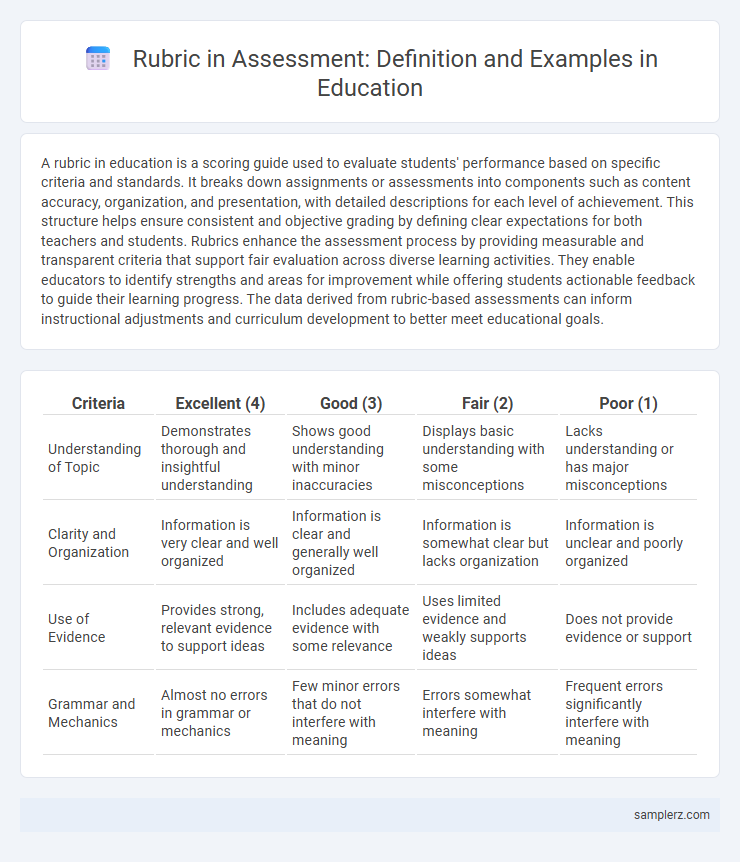A rubric in education is a scoring guide used to evaluate students' performance based on specific criteria and standards. It breaks down assignments or assessments into components such as content accuracy, organization, and presentation, with detailed descriptions for each level of achievement. This structure helps ensure consistent and objective grading by defining clear expectations for both teachers and students. Rubrics enhance the assessment process by providing measurable and transparent criteria that support fair evaluation across diverse learning activities. They enable educators to identify strengths and areas for improvement while offering students actionable feedback to guide their learning progress. The data derived from rubric-based assessments can inform instructional adjustments and curriculum development to better meet educational goals.
Table of Comparison
| Criteria | Excellent (4) | Good (3) | Fair (2) | Poor (1) |
|---|---|---|---|---|
| Understanding of Topic | Demonstrates thorough and insightful understanding | Shows good understanding with minor inaccuracies | Displays basic understanding with some misconceptions | Lacks understanding or has major misconceptions |
| Clarity and Organization | Information is very clear and well organized | Information is clear and generally well organized | Information is somewhat clear but lacks organization | Information is unclear and poorly organized |
| Use of Evidence | Provides strong, relevant evidence to support ideas | Includes adequate evidence with some relevance | Uses limited evidence and weakly supports ideas | Does not provide evidence or support |
| Grammar and Mechanics | Almost no errors in grammar or mechanics | Few minor errors that do not interfere with meaning | Errors somewhat interfere with meaning | Frequent errors significantly interfere with meaning |
Understanding Rubrics in Educational Assessment
A rubric in educational assessment serves as a tool to clearly define criteria and performance levels, enabling consistent and objective grading of student work. For example, a writing rubric might assess organization, clarity, grammar, and content accuracy, with each criterion rated on a scale from 1 to 4. This structured approach enhances transparency for both educators and students, promoting fair evaluation and targeted feedback.
Key Elements of an Effective Assessment Rubric
An effective assessment rubric clearly defines criteria such as clarity, consistency, and specificity to guide evaluation. Key elements include well-articulated performance levels that describe varying degrees of mastery, enabling objective and transparent grading. Incorporating measurable indicators ensures reliable feedback and supports student learning outcomes in educational settings.
Sample Rubric for Classroom Projects
A sample rubric for classroom projects typically includes clear criteria such as creativity, content accuracy, presentation skills, and teamwork, each rated on a scale from poor to excellent. This structured assessment tool provides students with transparent expectations and helps educators evaluate project components consistently and objectively. Utilizing rubrics enhances student learning by identifying strengths and areas for improvement in project-based assignments.
Example of a Rubric for Written Assignments
A rubric for written assignments typically includes criteria such as clarity, organization, grammar, and content accuracy, each rated on a scale from excellent to poor. Performance descriptors define expectations for each level, guiding students in improving their work and enabling consistent grading by educators. This assessment tool enhances transparency and objectivity, ensuring detailed feedback on written communication skills in educational settings.
How to Create a Rubric for Group Work Assessment
A rubric for group work assessment should clearly define criteria such as collaboration, communication, task completion, and problem-solving abilities. Assign specific performance levels with detailed descriptors to differentiate between exemplary, proficient, and developing work in each category. Incorporating measurable indicators like participation frequency, quality of contributions, and adherence to deadlines ensures objective and consistent evaluation of group dynamics and outcomes.
Rubric Example for Oral Presentations
A rubric example for oral presentations includes criteria such as content accuracy, clarity of speech, engagement with the audience, and use of visual aids, each rated on a scale from 1 to 5. Effective rubrics specify performance levels ranging from novice to exemplary, providing detailed descriptors for each level to guide both evaluators and students. This structured assessment tool enhances objectivity and supports targeted feedback for improving presentation skills.
Utilizing Rubrics for Formative Assessment
Utilizing rubrics for formative assessment enhances student learning by providing clear criteria for performance and enabling targeted feedback. A well-designed rubric outlines specific learning objectives, such as critical thinking or problem-solving skills, with descriptive levels of achievement that guide students' progress. This structured approach helps educators identify areas for improvement and adjust instruction to support ongoing development effectively.
Digital Tools to Design Assessment Rubrics
Digital tools like Google Forms, RubiStar, and Quick Rubric streamline the creation of assessment rubrics by enabling educators to customize criteria and performance levels for various learning objectives efficiently. These platforms support collaborative rubric development, real-time feedback integration, and automatic score calculation, enhancing both teacher workflow and student understanding. Incorporating digital rubric tools ensures consistent, transparent, and data-driven assessment practices in education.
Adapting Rubrics for Diverse Learners
Adapting rubrics for diverse learners involves modifying criteria to align with varied learning needs, such as incorporating language accommodations for English language learners and adjusting performance levels to reflect differing cognitive abilities. Effective rubrics use clear, specific descriptors that allow for flexible assessment while maintaining academic standards. These tailored assessment tools enhance fairness and provide meaningful feedback, supporting inclusive education environments.
Benefits of Using Rubrics in Student Evaluation
Rubrics provide clear criteria that enhance consistency and objectivity in student evaluations, ensuring fair and transparent grading. They facilitate detailed feedback, guiding students in understanding their strengths and areas for improvement. Using rubrics also streamlines the assessment process, saving time while promoting higher-quality learning outcomes.

example of rubric in assessment Infographic
 samplerz.com
samplerz.com